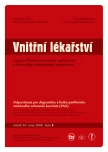Importance of the endocannabinoid system in the regulation of energy homeostasis
Authors:
T. Kvasnička
Authors‘ workplace:
III. interní klinika 1. lékařské fakulty UK a VFN Praha, přednosta prof. MUDr. Štěpán Svačina, DrSc., MBA
Published in:
Vnitř Lék 2008; 54(2): 191-194
Category:
Review
Overview
The endocannabinoid system is an endogenous signaling system that plays a role in the regulation of energy homeostasis and lipid and glucose metabolism-all of which can influence cardiometabolic risk. The endocannabinoid system appears to be a promising novel mechanistic pathway that modulates important aspects af cardiovascular and metabolic function. The endocannabinoid system is normally a silent physiologic system that becomes transiently activated, that is, only when needed. Evidence suggests that the endocannabinoid system is tonically overactive in human obesity and in animal models of genetic and diet-induced obesity. However, there is evidence in studies that the ECS is tonically overactivated in obesity, although it remains unclear whether overactivation of the ECS precedes or is consequent to expression of the obese phenotype. Rimonabant, a selective cannabinoid-1 receptor (CB1) blocker, has been shown to reduce smoking, body weight and improve and improves the profile of several metabolic risk factors in high-risk patients.
Key words:
endokannabinoids - anadamid receptors CB1, CB2 - obesity - cardiometabolic risk - rimonabant
Sources
1. Matsuda LA, Lolait SJ, Brownstein MJ et al. Structure of a cannabinoid receptor and functional expression of the cloned cDNA. Nature 1990; 346: 561-564.
2. Pagotto U, Marsicano G, Cota D et al. The emerging role of the endocannabinoid system in endocrine regulation and energy balance. Endocr Rev 2006; 27: 73-100.
3. Howlett AC, Barth F, Bonner TI et al. International Union of Pharmacology. XXVII. Classification of cannabinoid receptors. Pharmacol Rev 2002; 54: 161-202.
4. Katona I, Sperlagh B et al. Presynaptically located CB1 cannabinoid receptors regulate GABA release from axon terminals of specific hippocampal interneurons. J Neurosci 1999; 19: 4544-4558.
5. Bensaid M, Gary-Bobo M, Esclangon A et al. The cannabinoid CB1 receptor antagonist SR 141716 increases Acrp30 mRNA expression in adipose tissue of obese fa/fa rats and in cultured adipocyte cells. Mol Pharmacol 2003; 63: 908-914.
6. Gebremedhin D, Lange AR, Campbell WB et al. Cannabinoid CB1 receptor of cat cerebral arterial muscle functions to inhibit L-type Ca2+ channel current. Am J Physiol 1999; 266: H2085-H2093.
7. Liu J, Gao B, Mirshahi F et al. Functional CB1 cannabinoid receptors in human vascular endothelia I cells. Biochem J 2000; 346: 835-840.
8. Wagner JA, Jarai Z, Batkai S et al. Hemodynamic effects of cannabinoids: coronary and cerebral vasodilation mediated by cannabinoid CB, receptors. Eur J Pharmocol 2001; 423: 203-210.
9. Maccarrone M, Bari M, Lorenzon T et al. Anandamide uptake by human endothelia I cells and its regulation by nitric oxide. J Biol Chem 2000; 275: 13484-13492.
10. Cota D, Marsicano G, Tschop M et al. The endogenous cannabinoid system affects energy balance via centra I orexigenic drive and peripherallipogenesis. J CIin lnvest 2003; 112: 423-431.
11. Engeli S, Bohnke J, Feldpausch M et al. Activation of the peripheral endocannabinoid system in human obesity. Diabetes 2005; 54: 2838-2843.
12. Devane WA, Hanus L, Breuer A et al. Isolation and structure of a brain constituent that binds to the cannabinoid receptor. Science 1992; 258: 1946-1949.
13. Mechoulam R, Ben-Shabat S, Hanus L et al. Identification of an endogenous 2-monoglyceride, present in canine gut, that binds to cannabinoid receptors. Biochem Pharmacol 1995; 50: 83-90.
14. Sugiura T, Kondo S, Sukagawa A et al. 2-Arachidonoylglycerol: a possible endogenous cannabinoid receptor ligand in brain. Biochem Biophys Res Commun 1995; 215: 89-97.
15. Hentges ST, Low MJ, Williams JT Differential regulation of synaptic inputs by constitutively released endocannabinoids and exogenous cannabinoids. J Neurosei 2005; 25: 9746-9751.
16. Pertwee RG Inverse agonism and neutral antagonism at cannabinoid CB1receptors. U Sci 2005; 76: 1307-1324.
17. Šulcová A Význam endokanabinoidního systému v modulaci kardiometabolických rizikových faktorů. Vnitř Lék 2006, 52: 615-618.
18. Cota D, Woods SC The role of the endocannabinoid system in the regulation of energy homeostasis. Cur Opin Endoerinol Diabetes 2005; 12: 338-351.
19. Sharkey KA, Pittman QJ Centra I and peripheral signaling mechanisms involved in endocannabinoid regulation of feeding. Sci STKE 2005; 277: 15.
20. Kirkham TC, Williams CM, Fezza F et al. Endocannabinoid levels in rat limbic forebrain and hypothalamus in relation to fasting, feeding and satiation: stimulation of eating by 2-arachidonoyl glycerol. Br J Pharm 2002; 136: 550-557.
21. Willerson JT, Ridker PM. Inflammation as a cardiovascular risk factor. Circulation 2004; 109: (Suppl): 1-2.
22. Di Marzo V, Goparaju SK, Wang L et al. Leptin-regulated endocannabinoids are involved in maintaining food intake. Nature 2001; 410: 822-825.
23. Williams CM, Rogers PJ, Kirkham TC. Hyperphagia in pre-fed rats following oral delta9-THC. Physiol Behav 1998; 65: 343-346.
24. Osei-Hyiaman D, DePetrillo M, Pacher P et al. Endocannabinoid activation at hepatic CB1 receptors stimulates fatty acid synthesis and contributes to diet-induced obesity. J Clin lnvest 2005; 115: 1298-1305.
25. Liu YL, Connoley IP, Wilson CA et al. Effects of the cannabinoid CB1 receptor antagonist SR141716 on oxygen consumption and soleus muscle glucose uptake in Lep(ob)/Lep(ob) mice. Int J Obes Relat Metab Disord 2005; 29: 183-187.
26. Kola B, Hubina E, Tucci SA et al. Cannabinoids and ghrelin have both central and peripheral metabolic and cardiac effects via AMP¬activated protein kinase. J Biol Chem 2005; 280: 25196-25201.
27. Lichtman AH, Cravatt BF. Food for thought: endocannabinoid modulation of lipogenesis. J Clin Invest 2005; 115: 1130-1133.
28. Hradec J. Endokanabinoidní systém - nový léčebný cíl u multirizikových nemocných. Remedia 2005; 15: 163-168.
Labels
Diabetology Endocrinology Internal medicineArticle was published in
Internal Medicine

2008 Issue 2
Most read in this issue
- Peripheral arterial disease of extremities – guidelines for diagnostic and treatment
- Monitoring of anti-tumour cell-mediated response in patients with renal cell carcinoma, disturbance of T cell proliferation
- Current Use of Magnetic Resonance Imaging in Cardiology
- The scintigraphic 99mTc-MAA imaging quantification of the right-to-left shunt in a patients with multiple pulmonary arteriovenous malformation and familial teleangiectasis
